Various Ford 289 Small Block V8 Engine Choices for Tearing Up the Tarmac in the Swingin' '60's
Posted by D. Brian Smith on May 3rd 2024
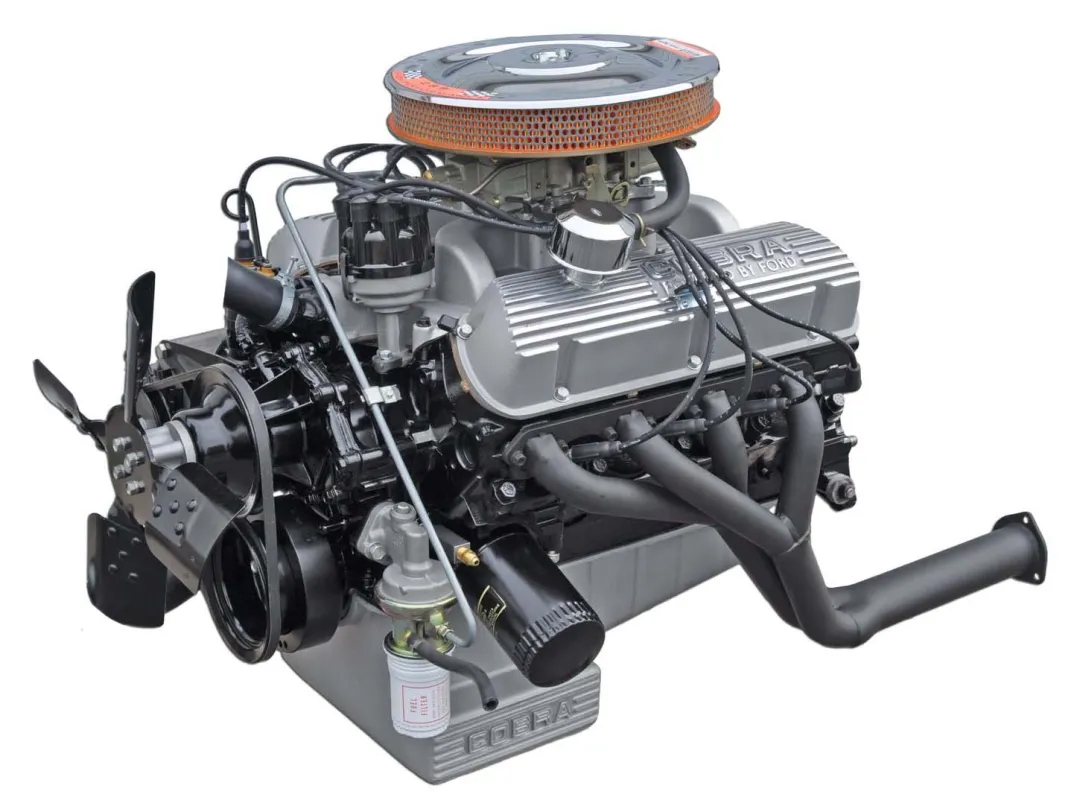
First generation Ford Mustang enthusiasts know that the fastest 1965-66 Ford Mustangs are the Shelby GT350 2+2's. Most of these limited production Shelby's were thinly disguised SCCA race cars that were built for the street for homologation purposes. A scant 36 of them were full-on racing machines that dominated SCCA B production racing in 1965 and 1966. These beauteous beasts are still vintage raced to this day. They're often competing heads-up against 1963-65 Shelby Cobra 289-powered roadsters.
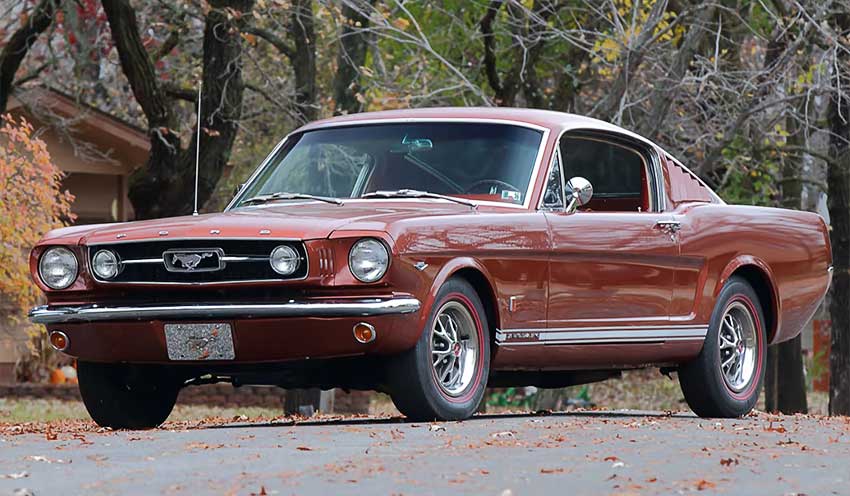

Mustang K Code, GT350, & 289 Cobras - Same V8
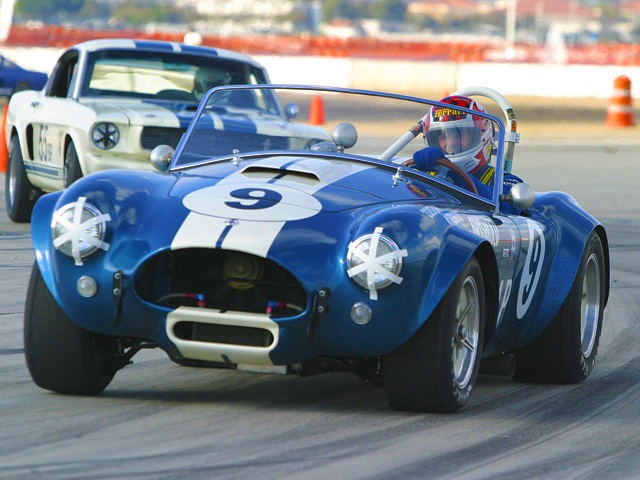
Above: A Shelby 289 Cobra roadster battles it out in the B Production classification with a 1965 Shelby GT350 Mustang competition model giving chase at a vintage race held on Coronado Island, San Diego, CA. Photo courtesy of the author.
Options Galore For the 1966 Mustang
These phenomenal Ford vehicles all share the same powerplant - the solid lifter, high performance version of the mighty 289-cubic inch small block V8 that the Ford Motor Company dubbed the K code High Performance engine way back in 1963. This mill first appeared in the Mustang in 1964 (or 1964.5 if you prefer). The K code was available in a Mustang notchback coupe, a convertible, or a 2+2 (also known as a fastback). The K code High Performance Mustang could either be ordered as a regular Mustang with four-wheel drum brakes. Otherwise, it could be optioned as a GT, with the front disc brake setup and rear drums, a GT badge on the front fenders, the GT rocker panel stripes, dual exhausts that exit through the rear valance panel, fog lamps, and etc. Customers could either select a standard interior or a Pony Interior.
1965 Shelby GT350 Mustang - Bare Bones Race Car
There were a myriad number of ways that Mustang customers could equip their Mustangs, with the exception of the Shelby GT350. In 1965, you could either get a Wimbledon White GT350 with Guardsman Blue Le Mans stripes or without the stripes. You had black vinyl bucket front seats and to save weight, a deleted fold down back seat with a seat tray and spare tire in its place.
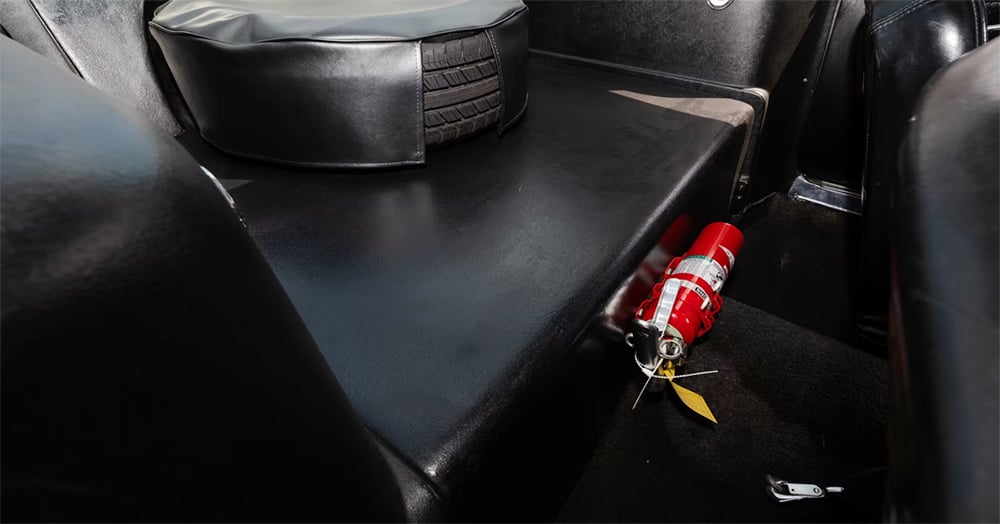
Above: All 562 1965 Shelby GT350 Mustangs were sold with the fold down rear seat removed and a seat tray with the spare wheel/tire in its place. The added fire extinguisher is a smart accessory for this race car for the street (or the track).
You could either select steel wheels or various mag wheels. Your only choice for transmission was a four-speed manual Borg Warner T10 trans. If you were one of the lucky 36 customers who paid big bucks for the competition model, then you got a full-on SCCA legal race car that you could race and win in B production (if you could drive/race that is).
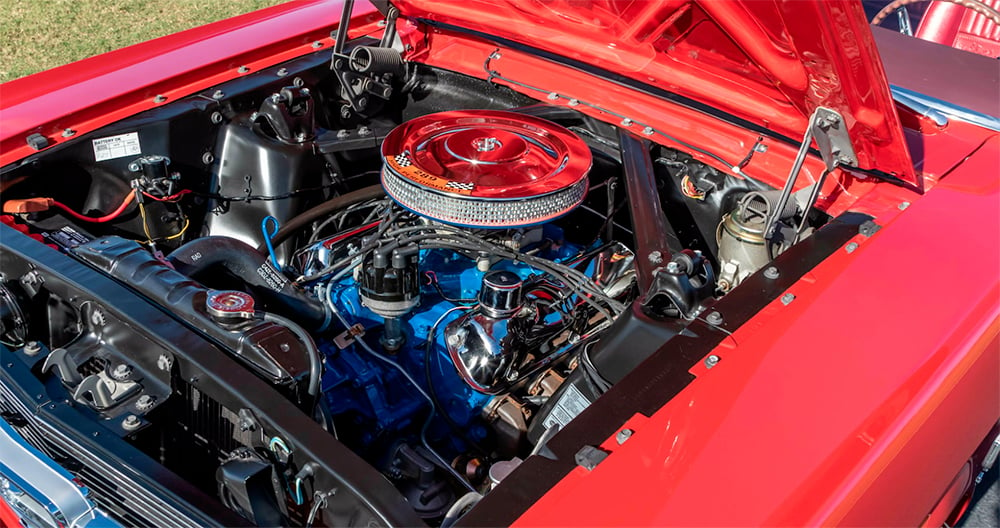
Above: K code engines are easy to identify. The K code engine will not have a vacuum advance on the front of the distributor. K codes all utilized solid lifters. All K code engines accordingly had mechanical advance distributors with dual points. The distributor housing was smooth and had no provision for a vacuum advance.
About a year after this humble scribe purchased his daily driver Wimbledon White Mustang C code fastback in the mid-1990's, there was a classified ad in the San Francisco Chronicle newspaper for an Emberglo Mustang K code High Performance fastback GT. Shortly after talking to the seller on the phone on a San Mateo, CA spring Saturday, I made the 1.5-hour drive to Oakland, CA to inspect the High Performance K code 1966 Emberglo GT 2+2 in my 1965 Mustang.

Above: The four-barrel carburetor topped A code engine has hydraulic lifters, so there is a vacuum advance on the front of the distributor.
The Emberglo GT owner had listed his Mustang for about twice as much as I had originally paid for my Mustang C code. If his High Performance K code GT was the real deal, it would be a steal at even twice the price. Upon arrival, the car looked awesome at first glance. The bodywork was wave free and laser straight. Someone had done a phenomenal job of sanding, priming, painting, color sanding, and clear coating. The body panel gaps were all even and factory fresh. You could almost smell the fresh paint drying in the sun. The Emberglo paint job had no blemishes, cracks, chips, runs, or orange peel. This GT K code looked to be the genuine article.
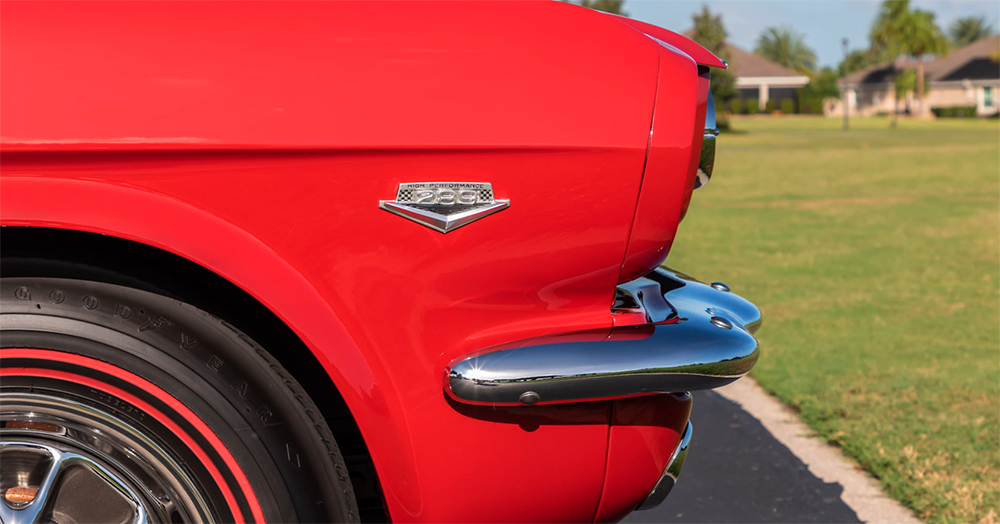
Above: If the 1966 Mustang is equipped with a K code engine, the 289 front fender badges on the left and the right fender will have a High Performance, checkered flag badge that mounts behind the 289 emblem like the one shown here. Otherwise, if your 1966 Mustang is powered by a V8, it will simply be a 289 emblem without the checkered flag and the High Performance.
All of the exterior badging identified the Mustang as a High Performance K code GT 2+2, which is the top of the mountain in the high performance, 1966 Mustang world, apart from the very limited-production Shelby GT350. The 289 High Performance K code engine has a hotter solid-lifter camshaft, cylinder heads, a dual-point ignition designed for higher revs, cast-iron header exhaust manifolds, and a wider harmonic balancer.
Once I opened the hood, my K code imposter siren went off in my head, and I was seeing red. My eyes first went to the front of the engine, where the distributor resides. There was a vacuum advance on the front of the distributor. This meant that this engine did not have a dual-point ignition. This distributor was the one used for the hydraulic-lifter camshaft engines found in the less powerful C code and the A code Ford '66 Mustang 289 V8's.
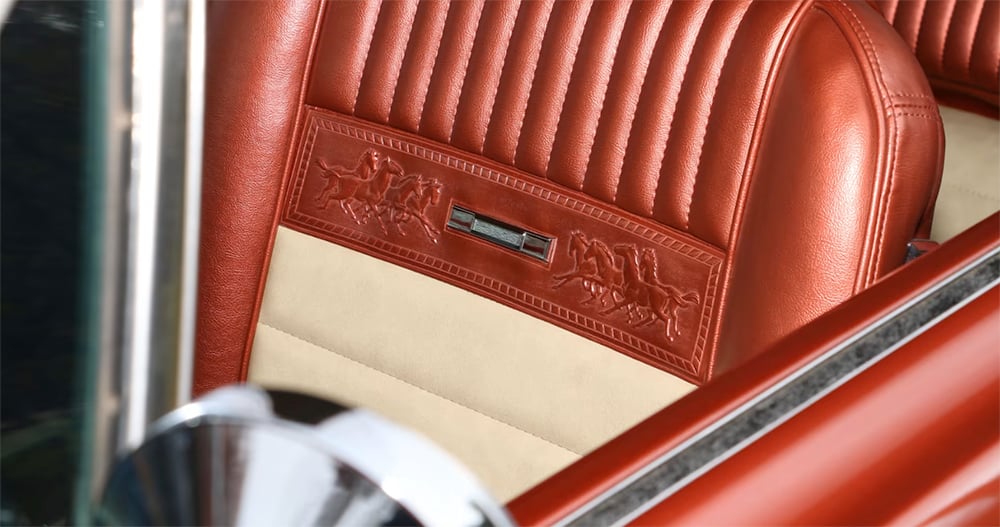
Above: The deluxe Pony Interiors for the 1964-1966 Mustangs had embossed Ponies running wild on the front seat backs. The seats could either be one hue or two, as is the case with the Emberglo and Parchment seats above and the Medium Blue and White Pony Interior shown below.
I next walked to the driver's side of the car. There's a notch in the driver's side front fender where the Mustang's VIN is located. The VIN that was stamped on top of the engine bay fender apron identified this Mustang as having an A code engine. The VIN is also stamped on the Mustang's data plate, which is riveted on the driver's side door back. I asked the owner's permission to open the door and look at the plate. He of course said yes. The data plate also indicated that the Mustang had been born with an A code engine.
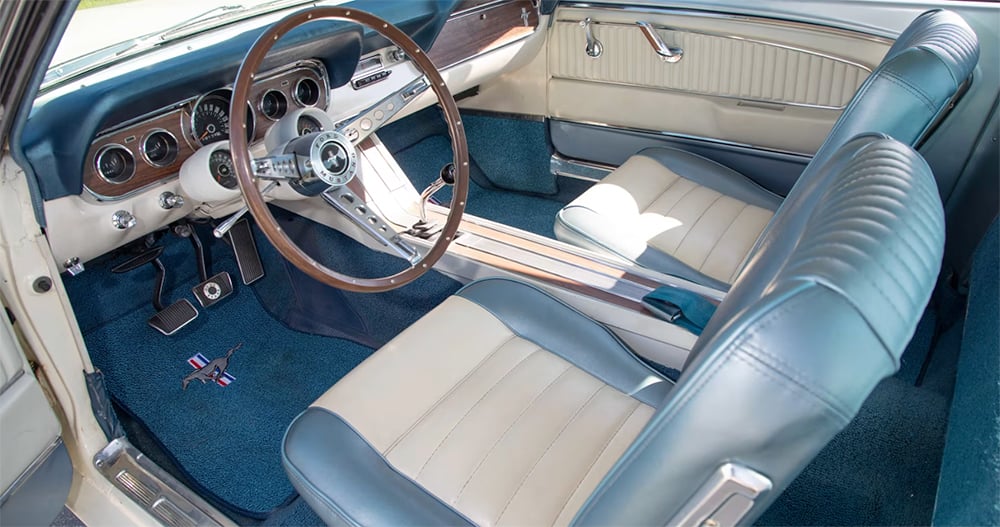
Ford factory-installed 289 High Performance K code engines also have the vehicle serial number stamped into the righthand side of the engine block near the battery's negative-cable attachment point. I didn't bother to look for the engine-stamped serial number, as I had seen enough with the distributor, the stamped VIN with the A in the fifth position as opposed to a K, and the data plate with the same A vin code. The top line of the data plate did display the correct information, in terms of how the Mustang was equipped, the: body, color, trim, manufacture date, DSO, axle ratio, and transmission were all spot on matches.
I thought to myself, 'this guy doesn't know what he has or he's trying to scam someone into paying too much.' Without sounding like I was Mr. Vintage Mustang, I told him that his Emberglo GT Mustang wasn't a High Performance K code. It was an A code. When I explained this to him, he blushed; his face turned red. This is when I knew I had caught him trying to scam me or the next person who shows up to buy the fake K code Mustang GT.
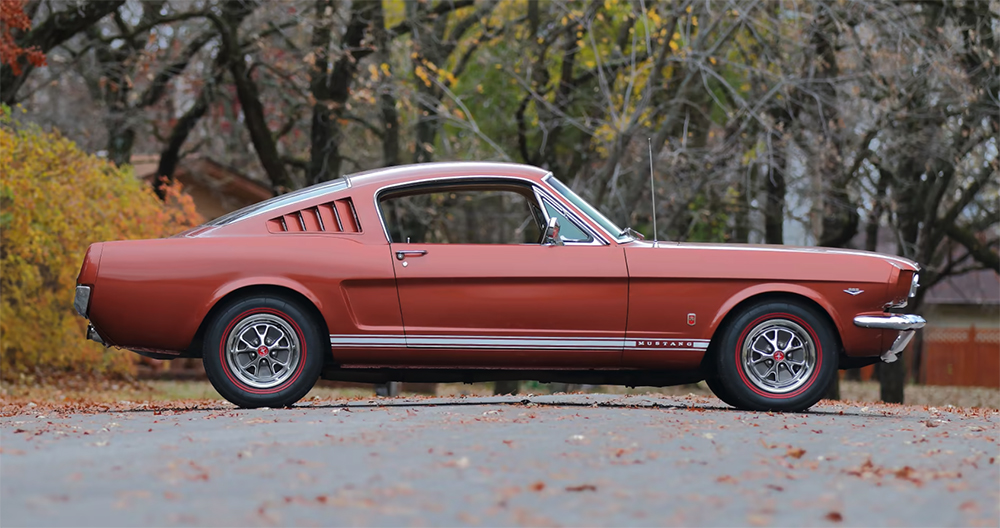
Above: Emberglo was a rare paint hue that was only used on the Ford Mustang for the 1966 model year. In the mid 1990's, the author almost purchased a 1966 Emberglo Mustang GT fastback that supposedly had a K code, high performance V8 engine. It looked just like the Emberglo GT A code fastback in this article, except for the fact that it was wearing the High Performance 289 K code badges on the front fenders.
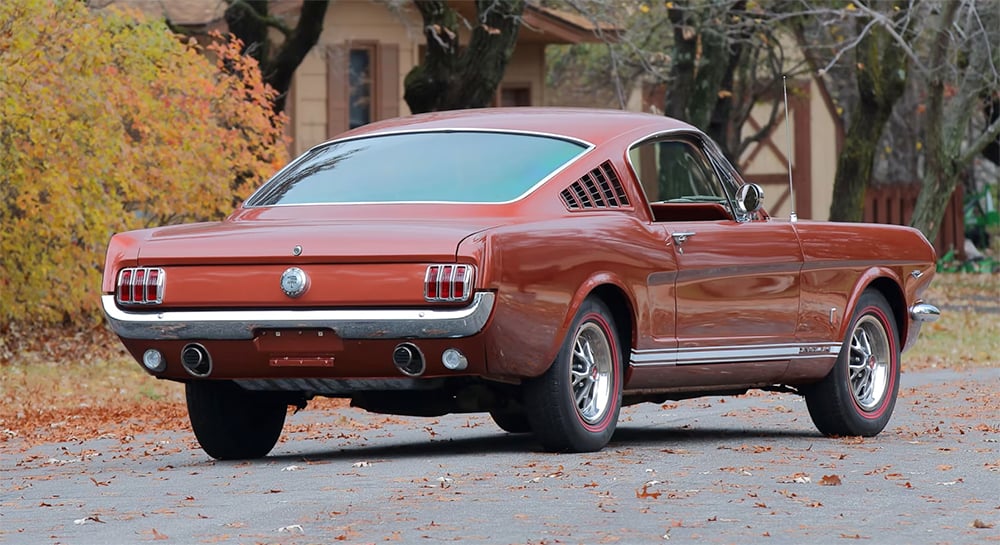
Though the Mustang looked and sounded awesome, I was too disappointed to even take it for a test drive. The seller was misrepresenting what it was. Who knows what else was incorrect on the car? For all I knew, it could have been a bondo mobile.
On that drive home to San Mateo that sunny day in May, I drove the snot out of my Wimbledon White, dependable daily driving 1965 Mustang, with a smile overtaking my frown with each successive mile. Back in the '90's, the fuel was even cheap in The Golden State!
The moral of the story is that life is good, when you have an American pony or muscle car. Whether it's worth a ton of money and sits in your garage, or you drive the heck out of it on a daily basis, or anything in between, it's a smile inducing time travel machine. Just know that you need to do some research before you go and look at a vehicle. You need to know what you might be buying. If it's an A code pretending to be a K code, as in this example, it's probably not worth your time, toil, and money. Here's an article that can help you from making those bad muscle car purchase and restoration mistakes: Top 12 Restoration Mistakes.

Above: That's what an A code VIN / Serial number looks like and what a 1966 Mustang A code 2+2 GT looks like in the rare hue of Emberglo.
1966 Mustang V8 Engine Codes & Specifications
| Engine Code | Years Produced | CID | Bore | Stroke | Compression Ratio | Horsepower | Torque |
| A | 1965-67 | 289 CID | 4.00" | 2.87" | 10.0:1 | 225 hp @ 4,800 RPM | 305 lb-ft @ 3,200 RPM |
| C | 1965-68 | 289 CID | 4.00" | 2.87" | 9.3:1 | 200 hp @ 4,400 RPM | 282 lb-ft @ 2,400 RPM |
| K | 1964-67 | 289 CID | 4.00" | 2.87" | 10.5:1 | 271 hp @ 6,000 RPM | 312 lb-ft @ 3,400 RPM |

Above and two below: The above photograph and VIN / Serial number identifies and shows what a K code 1966 Mustang GT fastback looks like.
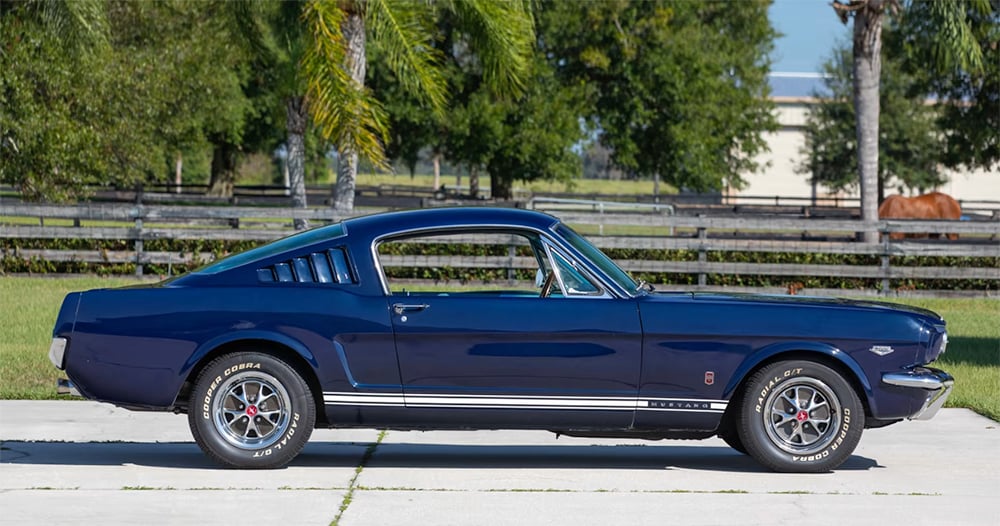
Above and below: A genuine K code 1966 Mustang 2+2 GT will have all the badging and rocker stripes that are apparent on this Nightmist Blue (Ford Paint code E, PPG Ditzler paint code 13076) 1966 GT fastback K code example.

Above: Emberglo, red, and Nightmist Blue Mustang GT images all provided courtesy of Mecum Auctions. The lead photo of the K-code engine is a fully-dressed Shelby 350 GT V-8.

Above: The 1965-66 Shelby GT350 Mustangs all used the K code, 271-horsepower, solid lifter engine. These K code mills made 306-horsepower in the Shelby GT350's, because Shelby American installed a large four-barrel Holley 725 CFM carburetor that bumped up the power to 306 bhp (310 PS; 228 kW) at 6,000 rpm and 329 lb.⋅ft. (446 N⋅m) of torque at 4,200 rpm. This photo was taken at the world-famous Laguna Seca Raceway for the Rolex Monterey Motorsports Reunion by the author.
Parts Unlimited Interiors Is Building a Paddock of Pony Car Parts for the Ford Mustang
Lest you think that PUI doesn't cater to America's first pony car, you'd be incorrect in that assessment. Check out what's in the Mustang corral.
